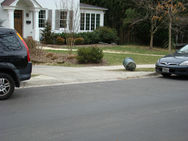Are Montgomery’s parking minimums really about parking?

Each driveway denies the public a parking space. Photo by the author.
Why does zoning require off-street parking? It’s natural to think that the idea is to create more parking spaces. But that’s not always so — and with zoning rewrites underway in Montgomery County and DC, it’s worth taking a careful look at what these rules do.
The most jealously-defended element of the parking mandates in Montgomery County is the one for single-family houses. New houses must have 2 spaces, even in areas zoned for ½-acre house lots where there is always plenty of space on the street.
While the planning board is recommending cuts to other parking minimums, the rules for houses will change only in downtown areas where no one builds single-family houses now anyway.
Moreover, the rule is only enforced to require building the parking, not using it. Garages that contain required parking spaces are often filled with equipment for lawn care or shop work. County enforcement staff say they have never received a complaint about such violations of the zoning ordinance.
Sometimes, requiring off-street parking actually reduces the availability of parking. Montgomery County mandates one off-street space for houses built between 1955 and 1958. A parking space for a single-family house requires a driveway (except in neighborhoods with alleys, which exist in DC but not MoCo). That takes away at least one parking space, and sometimes more if driveways are spaced closely together.
The parking space goes to waste in the daytime if the owner drives to work. Without an off-street space, there would be no need for a driveway and one more space would open up at the curb. The curb space, available 24 hours a day, would supply more parking than an off-street space that is useless during working hours.
These rules may not do much for those who want to park. But parking minimums do reduce the supply of affordable housing.
Montgomery County requires an extra parking space (and sometimes two) when a property owner splits off part of a house into an accessory apartment. If there’s no space to shoehorn the parking onto a small lot, the owner has to go through the time-consuming and expensive special exception process.
New apartment buildings near the Red Line and future Purple Line need underground garages, which can run up to $50,000 per space in lower levels. Driving up construction costs makes it harder to build for the middle class.
From this vantage point, the debate over off-street parking is about much more than where people put their cars. It’s about what kind of communities we want to live in. Will our laws put economic limits on who can live here, or will we build places that welcome everyone?
